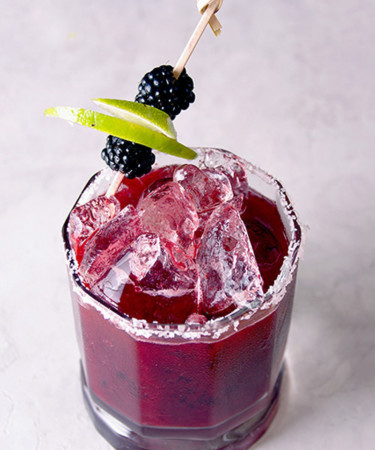When you think about drinking margaritas, you probably imagine sitting on a warm summer patio, or lounging on a tropical beach, sand between your toes and a frozen drink in hand. So it might come as a bit of a surprise to discover that National Margarita Day is in the middle of February, perhaps the coldest month of the year. If you haven’t got a vacation booked to celebrate Margarita Day in Cancun or Vallarta, and the thought of a frozen margarita in a blizzard makes your blood run cold, don’t you worry! Manny Hinojosa, mixologist and brand ambassador for Tequila Cazadores, has just the cocktail for you.
Arandas, in the South Jalisco Highland region of Mexico, is where a great deal of the blue agave plants used to make tequila are grown. It’s not the tropical beach or desert climate that come to mind when most people think of Mexico. The country is vast and the climates represented throughout its 31 states are varied. Jalisco sits at about 6,000 feet above sea level, and has a mild, temperate climate. In February, the temperature hovers just above freezing at night, getting up to the high 60s or 70s, even 80s during the day.
But agave is a versatile plant, as happy in these growing conditions as in the desert-like valleys below. Even snow doesn’t stop them! Last year, wild speculation from tequileros in the U.S. made headlines predicting a massive 2020 tequila shortage, after Jalisco saw its first snowfall in almost two decades. But according to Hinojosa, those fears were unwarranted. “We are really high in the mountains,” he says. “Nothing happened. It was just beautiful to have the snow in the fields, and a day later everything was melted and back to normal.” The blue agave grown for Tequila Cazadores takes between seven and nine years to mature — long enough, he says, that even if weather or blight did damage a crop, more agave could be planted to make up for the loss.
While the class margarita is easy to make — it’s just tequila, agave syrup, and fresh lime juice, on ice — the drink can be complicated and concocted to suit just about any taste. Use a blanco, reposado, or añejo tequila, but not an extra añejo, which has been aged longer in oak barrels and, in Hinojosa’s opinion, would be wasted in a mixed drink.
For a warming evening margarita to sip by the fire, Hinojosa recommends this pumpkin spice- flavored concoction that won him a mixology competition in San Francisco a decade ago — “before Starbucks started the Pumpkin Spice Latte craze,” he says.
Pumpkin Margarita
Ingredients:
- 1 ½ ounces tequila
- 1 ounce pumpkin spice liqueur
- 2 ounces orange juice
- ½ ounce lemon juice
- A dash of powdered cinnamon
In a cocktail shaker, combine all the ingredients with ice, shake, and serve on the rocks. Rim the glass with cinnamon and sugar, and add an orange peel for garnish.
But say you are over the pumpkin spice craze, or just want an afternoon cocktail that’s both refreshing and warm. In that case, Hinojosa enjoys this mix of blackberries and ginger. He developed this recipe while touring Europe, preparing cocktails at ski resorts and outdoor winter sports events in 2009, and still wins compliments and competitions with it to this day.
Winter Blackberry Ginger Margarita
Ingredients:
- 1 1/2 ounces tequila
- 3/4 ounce Perfect Puree Blackberry
- 3/4 ounce agave nectar
- 3/4 ounce fresh lime juice
- 1 slice ginger
- Salt rim optional
In a mixing glass, muddle slice of ginger. Add the rest of the ingredients with ice, shake vigorously. and serve over the rocks. Garnish with lime wheel and fresh blackberry.
Whether you whip up a traditional margarita today or try out something a bit different, take some time to celebrate the brilliance of the tequila and lime mix. Have a happy Margarita Day! Sit back, sip, and enjoy.


